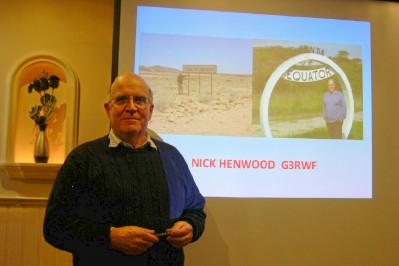
Nick Henwood G3RWF was licensed in 1963 while still at school. He started African DX-ing by getting the call sign 9L1NH only six months later while on Voluntary Service Overseas in Sierra Leone. In the last nine years he has been on the air from Africa on 23 separate occasions – sometimes doing voluntary work and sometimes on holiday. He has almost always been solo and carrying all his gear with him. He has been 11 times to Uganda - principally as a volunteer university consultant and has now made more QSOs as 5X1NH than as G3RWF. His most recent trip was to Rwanda last March and he hopes to be back on the air from Lesotho as 7P8NH in three weeks time. At the meeting he talked about getting an antenna up, and working DX when you are on your own. In this report the slide photographs are used with Nick's kind permission.

Nick was introduced by LRS meetings coordinator Malcolm Hamilton GM3TAL
who has known him for many years.


The impressive list of callsigns used by Nick over the years.
It was in Kenya where he first met LRS member Andre Saunders GM3VLB.

Travelling usually on his own, Nick's motto is "Keep it Light"!
He gets all his gear into one or two 23kg suitcases.

Two early pieces of NIck's equipment - the ex-gov't R-107 receiver and the Heathkit DX-40U and VF-1U.

More modern - the Yaesu FT-857 and the Icom IC-7000 100W transceivers.
Sadly, the IC-7000 was stolen on one of his trips.

Nick built his Elecraft K2 transceiver from a components kit in six weeks - no small feat.
He also has two K3s, bought when the exchange rate was 2.2 dollars to the pound!



An antenna analyzer is an essential item of test gear.


Fort Portal, Uganda.

NIck at his Elecraft K3 rig.

Nick's antennas are all lightweight and portable.

Verticals are wonderful if they can be located right beside the sea (salt water).
This one is supported by a lightweight 10m long fishing pole.

In this case the vertical can be seen about a quarter-way in from the left ...

... but it was not very close to any salt water!

An end-fed wire antenna with an antenna tuning unit is a compromise
and has not been very satisfactory on Nick's DXpeditions.

Dipoles, including inverted-Vees and other tuned antennas have been the most successful.

Inverted-Vee dipole supported at 45 feet by a lightweight fishing pole.

Lightweight multi-band dipoles can be constructed from simple materials such as
part of a chopping board for the centre, with a choke balun.

Short sections of PVC pipe can be used as insulators and wire clips for the selection of the band.

And if you're really stuck for an insulator, how about a plastic water bottle!


Of course, when you're up against kilowatt stations and you want to get a bit louder,
a beam helps, but they're not exactly lightweight and portable.

A portable beam such as the German Spiderbeam is much more suitable for Nick's purposes.
However, this location on Lake Victoria was not very effective with a beam height of only 20 feet
and fresh water rather than salty seawater.

A Spiderbeam (and friends), with a great take-off from the top of a hotel
on top of a hill, was much more successful.


2-Element Moxon beam on a fibreglass pole was very successful ....

.. winning the 15m low-power single-operator section of CQWW CW in 2012.

A Hexbeam has the same gain as a Moxon but is rotatable.

A Vertical Dipole Array is like a Moxon beam lying on its side, and providing a 6 degree take-off angle, but it does need a good earth e.g. located beside the sea!

L-R: Alan GM3PSP, Malcolm GM3TAL, NIck G3RWF & Andre GM3VLB
(Photo by Veronica, XYL-GM3VLB - tnx).

